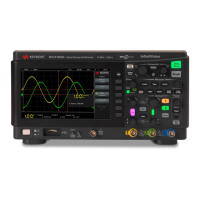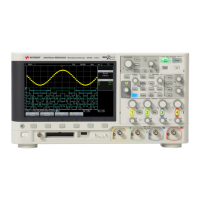Quick Reference 2
Keysight InfiniiVision DSOX1204A/G Oscilloscopes User's Guide 55
Overview of Sampling
To understand the oscilloscope's sampling and acquisition modes, it is helpful to
understand sampling theory, aliasing, oscilloscope bandwidth and sample rate,
oscilloscope rise time, oscilloscope bandwidth required, and how memory depth
affects sample rate.
Sampling Theory
The Nyquist sampling theorem states that for a limited bandwidth (band-limited)
signal with maximum frequency f
MAX
, the equally spaced sampling frequency f
S
must be greater than twice the maximum frequency f
MAX
, in order to have the
signal be uniquely reconstructed without aliasing.
f
MAX
= f
S
/2 = Nyquist frequency (f
N
) = folding frequency
Aliasing
Aliasing occurs when signals are under-sampled (f
S
< 2f
MAX
). Aliasing is the signal
distortion caused by low frequencies falsely reconstructed from an insufficient
number of sample points.
Table 17 Segmented Memory Acquisition Features
Feature Front Panel Key/Softkey Location (see built-in help for more information)
Segmented memory
acquisitions
[Acquire] > Segmented > Segmented, # of Segs, [Run] or [Single]
After each segment fills, the oscilloscope re-arms and is ready to trigger in about 19 µs. Remember
though, for example, if the horizontal time per division control is set to 5 µs/div, and the Time
Reference is set to Center, it will take at least 50 µs to fill all ten divisions and re-arm. (That is 25 µs
to capture pre-trigger data and 25 µs to capture post-trigger data.)
Segmented memory
navigation
[Acquire] > Segmented > Current Seg
Segmented memory
and persistence
[Display] > Persistence, Infinite
∞ Persistence or Variable Persistence
[Acquire] > Segmented > Analyze Segments
Segmented memory,
save to USB storage
device
[Save/Recall] > Save > Format (CSV, ASCII XY, or BIN) > Settings > Save Seg (Current, All)

